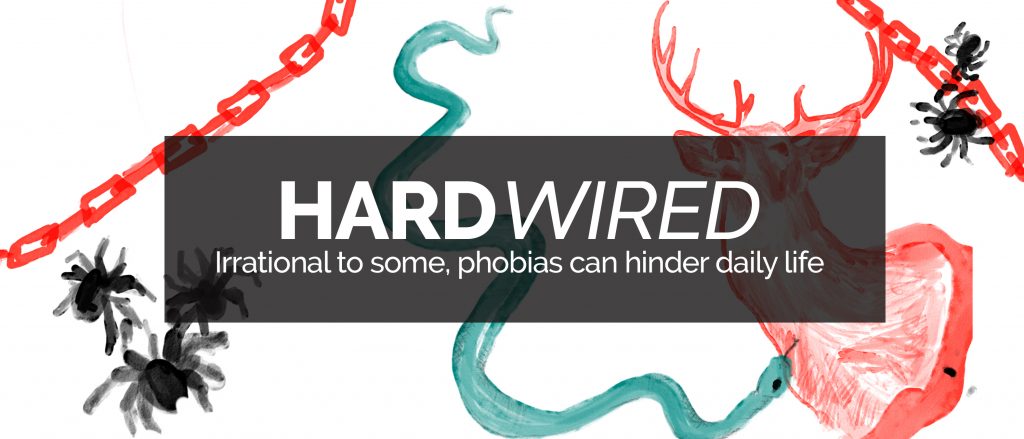
-illustrations by Maggie Roethle
Fear is often learned: Many fears stem from personal experience. You learn to react with fear when anticipating a negative outcome. Maybe you’re afraid of getting a shot because you’ve learned the outcome is experiencing nausea. Or you’re afraid of the possibility of falling from a great height or the potential bite of a spider.
But what happens when the same situation that instills paralyzing panic and anxiety in you seems completely un-scary to the general population? In fact, what if your worst fear simply doesn’t seem logical to most people?
Phobias surpass normal levels of fear altogether and instead involve excessive fear of a specific object, activity or situation that is not considered harmful or dangerous. According to the American Psychiatric Association, an estimated 7 to 9 percent of Americans experience phobias, which are a specific type of anxiety disorder.
Rachel Baldwin, a 23-year-old graduate of UW-Madison, vividly remembers unsuccessful attempts at convincing teachers of the extent of her phobia.
“In first grade, we went to Bubolz Nature Center, which is renowned for its collection of taxidermy, so it’s got like grizzly bears, polar bears, mountain lions,” Baldwin says.
Baldwin remembers insisting she couldn’t go in and trying to wait outside instead. Her teachers assumed she was exaggerating, as many first graders tend to do, and decided to bring her into the museum anyway.
“I remember a teacher being like, ‘Well we can’t leave you outside, you’re 5. This is so stupid. You have to come inside,’” Baldwin says. “That’s the first time I remember having a panic attack.”
To most, a nature center would probably not elicit any feelings of extreme fear, but Baldwin’s phobia gives her an arguably unique perspective. From cat dissections in AP Biology to the decorative deer heads on cabin walls in the Northwoods of Wisconsin, Baldwin has been uncomfortable with and afraid of what she terms “stuffed, imposing flesh” for as long as she can remember.
“It varies in degrees of intensity and reaction, depending on like what it is and how far away it is,” Baldwin says.
She experiences feelings of panic and anxiety when encountering all preserved animals, especially when they are larger in size, like a bear or wolf, and in close vicinity.
“I would say I have a pretty severe reaction, usually crying, running out of the room, leaving,” Baldwin says.
The human mind uses fear as a way to protect itself from danger. Usually, fear is a necessary, healthy response that corresponds to the level of danger in a situation.
With phobias, the outcome of significant physical or mental damage doesn’t actually match up with the object or situation, creating a perceived prediction of harm when there isn’t an actual threat of danger. This harm could be physical, like a spider bite, or psychological, such as having a panic attack due to fear.
This means that at some point in the many learned experiences of a person’s life, their brain has decided to assign a disproportionately large amount of fear to a specific, non-harmful stimulus.
From a clinical perspective, there are different psychological factors that go into why someone might develop a phobia.
One reason is because humans are hardwired to fear certain stimuli. These might be spiders, or snakes, two potentially dangerous animals that many people logically fear, to a certain extent.
Another factor is someone’s family history of anxiety, which might point to a higher likelihood of developing anxiety or a specific phobia.
The third factor in developing a phobia is a conditioning event that connects fear to a stimulus. This may be experiencing a dog bite or seeing a dog bite someone, triggering a phobia of dogs.
These different reasons all play into one another, according to Josh Cisler, assistant professor in the UW-Madison Department of Psychiatry. Cisler works in psychiatry research and outpatient therapy sessions, focusing on trauma adaptations that can create problems later in life, such as anxiety, post-traumatic stress disorder (PTSD) or depression.

“Let’s say you have no risk for anxiety. You can hear all the stories about dog bites that you can handle and you’re probably never going to develop a [dog] phobia,” Cisler says.
Phobias cause such extreme feelings of anxiety and distress that people with phobias change their behavior to avoid encountering what they fear. Anxieties and fears cross the threshold into phobia once the specific fear is something that stops you from living your life.
“You avoid the fear. And that reinforces the fear, and reinforces the avoidance, and they kind of feed into each other,” Cisler says.
This practice of avoidance as a coping mechanism actually creates a reinforcement of the fear itself, creating a short-term solution that perpetuates the fear, instead of a long-term solution.
“We would diagnose it when there’s some type of what we call ‘functional impairment,’” Cisler says. “When that fear prevents you from living the life that you prefer to live, that’s when we would consider a diagnosis.”
In general, people with phobias know that their level of fear isn’t rational, but they can’t use that logic to overcome or calm their anxiety. They’re aware that their reaction is heightened beyond that of most people.
“I really struggled with this because I think … my reaction is definitely irrational,” Baldwin says about of her phobia of taxidermy. “But then the more I think about it, I do a really good job of rationalizing why I would be afraid of it. Being like, ‘[taxidermy] is really unnatural.’”
We are all afraid of something, but phobias involve fear on a different level. We all know about the more common ones, such as arachnophobia — the fear of spiders. But there are other less known phobias that you may not have heard about. Video by Teodor Teofilov.
For Betsy Smith (whose name was changed to protect her privacy), an undiagnosed phobia of portable toilets affects how she chooses to live by limiting her ability to be in places with no access to indoor plumbing.
“I always have some sort of safety hatch,” Smith says. “So like if we are going to a festival, I won’t go unless I know like I can leave, or there is some place that [has] a permanent bathroom on the grounds that I can use.”
Avoidance has worked for Smith, because luckily she is not an avid camper, and her kids only participate in indoor activities, allowing her to generally be in settings with access to modern toilet facilities.
Although portable toilets aren’t the most desirable bathroom facilities to use, most people wouldn’t find using a portable toilet terrifying.
“I’ve worried that there’s rats and snakes and that they live down in the pit part,” Smith says.
For someone looking for ways to address a phobia, exposure therapy is the main and most reliably effective means of treatment.
According to the Evidence-Based Behavioral Practice Project, most estimates of exposure therapy’s success rates range from 60 to 90 percent. This wide range of effectiveness can be explained by differing definitions of success, as well as the highly personal and variable nature of each person’s specific phobia.
The main purpose of exposure therapy is to rewire the brain’s connection between the feared object or situation, and the reality of the actual outcome. Exposure therapy is based on confronting the feared situation and breaking the cycle of avoidance, so the person can see for themselves that the situation isn’t as dangerous as they have built up in their mind.
“For example, I was working with a client who had a fear of flying,” says Polly Sackett, a licensed professional counselor-in-training who works with Connections Counseling and also has her own practice in Madison. “Throughout that process, would be us sitting and talking about it and … sort of doing a rehearsal within the confines of the office about how it could go.”
This particular therapy session lasted about eight weeks leading up to the client’s flight, and the sessions ended with the client feeling confident about her ability to comfortably travel by plane.
Sackett uses exposure therapy in her work with clients who want help with managing or alleviating their phobias, but she also takes a more humanistic approach by talking through what may have happened that resulted in the fear occurring.
“I often … encourage people to offer compassion toward themselves surrounding any of this work that they do, you know, surrounding irrational fears and be like, ‘Well, you know what, this is a part of the acceptance that, for whatever reason, this is the challenge that is in my way, and … that’s OK,’” Sackett says.
For Baldwin, two years of exposure therapy helped her feel more comfortable in certain settings, but ultimately did not completely erase her phobia of taxidermy.
“I become desensitized to certain animals,” Baldwin says. “Like my friend Maggie’s basement has a buck in it, and I’ve gotten to where I can even sleep in that room. Or like the Buck and Badger [in Madison], my friends do trivia there. And so the first time, I was really upset going in there. But then most recent times I can go in there and walk past the bear and sit by the moose. But even when I see a new moose, it’s like a brand new experience … how far away is it? Why is it here? What’s the lighting like?”
Baldwin has grown accustomed to the one taxidermied buck in her friend’s basement, but that doesn’t universally apply to all taxidermied animals. She’s back to square one with each new setting and taxidermied animal she sees. Baldwin has ultimately stopped her exposure therapy treatments, but through therapy, she did find that she could overcome her fears of a taxidermied object once she familiarizes herself with it.
Another type of treatment available to people with phobias — to help them cope with their fear — is meditation, which may help with managing feelings of panic when the phobia is triggered.
“You want to do it preventatively, so you’re doing this muscular relaxation or meditation where you’re just learning to chill yourself out,” says Robert McGrath, distinguished psychologist emeritus, at University Health Services at UW-Madison.
McGrath sees meditation as a core way of dealing with stress.
When a person encounters a situation that sets off their phobia, the ability to calm oneself down is important, and exercises with slow breaths and mindfulness can be helpful.
For Smith, therapy for her phobia isn’t something she’s interested in. Despite situations on long runs where portable toilets have stopped her from going about her business, the mother of two finds she’s content with continuing to avoid portable toilets.
“I mean I’ve gone 40 years with being uncomfortable, and I’ll just keep doing it,” Smith says.

Maggie, our art director, is a senior majoring in strategic communication with a certificate in graphic design. When she’s not deep in the layers of Adobe Illustrator, you can find her going for a run along to a "My Favorite Murder" podcast. Upon graduation, she hopes to be an art director at an advertising agency.